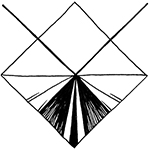HOW LONG DOES A TATTOO TAKE?
It can be hard to determine your ideal budget for a tattoo; how long does a tattoo take? If you haven’t already, please read my sliding scale payment policy and determine what you think you can afford using this framework as a guideline.
It depends on a lot of things! First, think really clearly about what you’re looking for. My hope is that you decide what YOU want, and determine your budget after deciding exactly what you want your tattoo to be, instead of letting your budget limit or determine what your tattoo looks like.
𓅯 𓅯 𓅯
PLACEMENT
Placement plays a huge part in determining how long a tattoo takes. In general, arms and legs are quicker tattoos, because they are even, flat planes to work on. This rule changes when you want your tattoo to wrap around an arm or leg, which requires a lot of readjustments to your sitting position during your tattoo session, and possibly design modifications and freehanded adjustments.
Generally, rib and stomach tattoos take the longest. A simple tattoo that would be on a low price range if placed on a leg could potentially double in price if placed on the ribs or stomach. This is because the skin stretches significantly, and tattooing takes twice as long with more skin to work with. They are also painful places to get tattooed, and may require lots of breaks for your comfort. Other time or pain intensive placements include necks, hands, feet, under-chin/jaw, and ears.
SIZE
Expect to split your tattoo into multiple sessions if it is something particularly big- like a sleeve or back piece, or any larger scale freehanded piece. Big pieces, in general, take longer. Big pieces especially take longer when in wrapping or complex placements, include freehanding, or include a lot of heavy black or intricate line detail. But if you want a very small, fine-line tattoo with a lot of detail, that may take just as long as a large piece with simple linework & minimal details. This is because the ultra fine line tight bugpin needles I use for tiny details must be used with a delicate, careful hand and slower application or they can easily “blow out” (permanently bruise or scar). Just because you want a small piece doesn’t necessarily mean it will cost less than if it were larger! This is a bit confusing, because I can pack a lot more solid, consistent, and visible (well-aging) detail into a larger tattoo. That being said, size is less important than detail…
DETAIL
Desired amount of detail can make a huge difference in how long a tattoo takes: often, my outlining takes a quarter of the time that it takes for me to build texture, and to craft sculpted line variations & intricate fine line details. Therefore, a more minimalist, linework-centered design would not take as long (unless that linework is in a fine line etching style)
I don’t mind making simple linework tattoos, but most people who are interested in my work are usually seeking a more “complete” looking piece with high contrast made using linework inspired by etchings & woodblock prints, as well as texture built via dotwork and pepper-shading. When submitting a proposal, think about what level of detail you are interested in: do you like a lot of texture, or a lot of negative space (skin)? Generally, animals like birds or mammals with a lot of feathers or fur require a lot of texture and mark-making.
Generally, I believe that my work looks best with texture and contrast. I am open to working on adding detail to your piece in a second session if you cannot afford it in the first, and also open to checking in with you as we add detail to make sure we don’t push over your pain threshold or budget.
CONTRAST
Contrast is important in building differentiation between the shapes in a drawing, especially in a tattoo that will change and fade with age (as all tattoos do— use sunscreen, y’all!) A high contrast tattoo with large areas of solid black and little to no pepper-shading will not take as long as an entirely pepper-shaded piece. Contrast can be achieved both ways, just with different approaches. I think contrast is important in most every tattoo, but minimalism (only linework, light shading with no black fill) can work too- just know that a high value range (more tonal variations) will take more time to craft.
